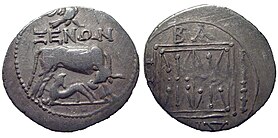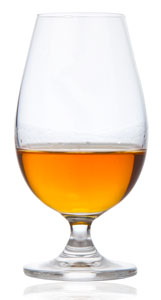Dram (unit)
The dram (alternative British spelling drachm; apothecary symbol ʒ or ℨ; abbreviated dr)[1][2]: C-6–C-7 [3] is a unit of mass in the avoirdupois system, and both a unit of mass and a unit of volume in the apothecaries' system.[2] It was originally both a coin and a weight in ancient Greece.[4] The unit of volume is more correctly called a fluid dram, fluid drachm, fluidram or fluidrachm (abbreviated fl dr, ƒ 3, or fʒ).[1][2]: C-17 [3][5][6][7]
Ancient unit of mass

- The Attic Greek drachma (δραχμή) was a weight of 6 obols, 1⁄100 Greek mina, or about 4.37 grams.[8]
- The Roman drachma was a weight of 1⁄96 Roman pounds, or about 3.41 grams.[9][10]
A coin weighing one drachma is known as a
British unit of mass
The British Weights and Measures Act of 1878 introduced verification and consequent stamping of apothecary weights, making them officially recognized units of measurement. By 1900, Britain had enforced the distinction between the avoirdupois and apothecaries' versions by making the spelling different:[11]
- dram now meant only avoirdupois drams, which were 1⁄16 of an avoirdupois ounce. An ounce consisted of 437.5 grains, thus making the dram approximately 27.34 grains.
- drachm now meant only apothecaries' drachms, which were 1⁄8 of an apothecaries' ounce of 480 grains, thus equal to 60 grains.
Modern unit of mass
In the
: C-14In the
"Dram" is also used as a measure of the powder charge in a shotgun shell, representing the equivalent of black powder in drams avoirdupois.[13]
Unit of volume

The fluid dram (or fluid drachm in British spelling[14]) is defined as 1⁄8 of a fluid ounce,[2]: C-5, C-7 and is exactly equal to:
- 3.6966911953125 U.S. customary system[2]: C-5, C-12
- 3.5516328125 ml in the British Imperial system[2]: C-7 [15]
A
While pharmaceuticals are measured nowadays exclusively in metric units, fluid drams are still used to measure the capacity of pill containers.
Dram is used informally to mean a small amount of
In popular culture
The line "Where'd you get your whiskey, where'd you get your dram?" appears in some versions of the traditional pre–Civil War American song "Cindy".[20] In the Monty Python's song "The Bruces' Philosophers Song", there is the line "Hobbes was fond of his dram". In the old-time music tradition of the United States, there is a tune entitled "Gie the Fiddler a Dram",[21][22] "gie" being the Scots language word for "give", brought over by immigrants and commonly used by their descendants in Appalachia at the time of writing. "Little Maggie," a traditional song popular in bluegrass music, refers to the title character as having a "dram glass in her hand."[23]
In the episode "Double Indecency" of the TV series Archer, the character Cheryl/Carol was carrying around 10 drams of Vole's blood and even offered to pay for a taxi ride with it.
In Frank Herbert's Dune, the Fremen employ a sophisticated measurement system that involves the drachm (and fractions thereof) to accurately count and economize water, an ultra-precious resource on their home, the desert planet Arrakis.
References
- ^ New English Dictionary, 1897.
- ^ OCLC 58927093. Retrieved 1 July 2012.
- ^ OCLC 181600928. Retrieved 2 July 2012.
- ^ New English Dictionary, 1897.
- OCLC 599509441.
- OCLC 44475779. Retrieved 2 July 2012.
Definition of FLUIDRAM: variant of fluid dram
- OCLC 622876101.
- ISBN 978-0-520-07844-4. Retrieved 30 June 2012.
- ^ Smith, William (1886). Dictionary of Greek and Roman Antiquities (3rd American ed.). New York: Harper & Brothers. p. 1062. Retrieved 1 July 2012.
- ^ Ramsay, William Wardlaw (1883). An elementary manual of Roman antiquities (7th ed.). London: Charles Griffin and Company. p. 206. Retrieved 1 July 2012.
- ^ "Apothecaries Weights". Retrieved 2016-09-21.
- OCLC 610190761. Archived from the original(PDF) on 3 June 2011. Retrieved 1 July 2012.
- ]
- ^ "The Weights and Measures Act 1985 (Metrication) (Amendment) Order 1994". www.legislation.gov.uk.
- OCLC 33237616. Retrieved 1 July 2012.
- New English Dictionary, 1911.
- ^ OCLC 700637572.
- ^ "Why is a measure of whisky called a dram?". TopWhiskies. Retrieved 2022-04-10.
- ^ Ritter, Francis D. (2000). Successful Personal Injury Investigation: Master the Techniques of Finding the Facts that Win Cases for Plaintiff Attorneys (First ed.). Oceanside, California: Diverse Publications. p. 804.
- ^ Erbsen, Wayne (1993). Front Porch Songs, Jokes & Stories. Native Ground. p. 12.
- ^ "The Milliner - Koken Collection of American Fiddle Tunes". slippery-hill.com. Archived from the original on 8 October 2015. Retrieved 15 September 2015.
- ^ Brown, John. Gie the fiddler a dram. Rec. May 1939 by Herbert Halpert. Lib. of Cong. Web. 15 September 2015. <http://www.loc.gov/item/afc9999005.7452>.
- ^ "Little Maggie – Bluegrass Lyrics".
External links
- Appendix C – General Tables of Units of Measurement in Specifications, Tolerances, and Other Technical Requirements for Weighing and Measuring Devices. NIST Handbook 44 (2012 ed.).
- Image Archived 2014-12-02 at the Wayback Machine of Ancient Greek silver drachm with flying Pegasus, Acarnania, Leucas, c. 470–450 BCE
